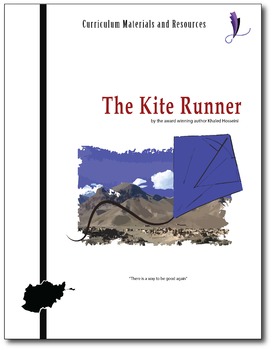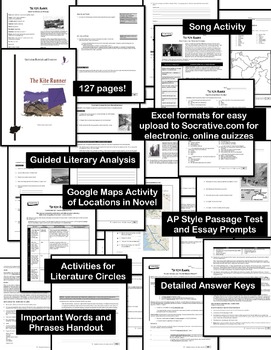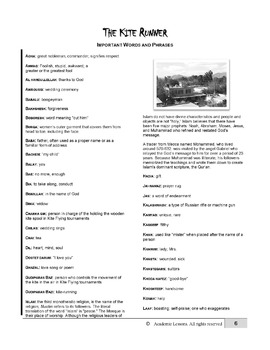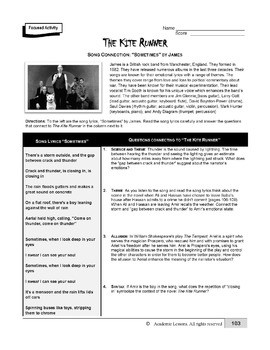"The Kite Runner" EDITABLE COMPLETE UNIT Activities,Tests,Analysis,AP Style,Keys
- Zip
What educators are saying
Description
A 127 page COMPLETE unit on the novel! NO "FLUFF": This unit focuses on LITERARY DEVICES, SKILLS APPLICATION, and LITERARY ANALYSIS. Unit includes reading guide questions and quizzes, literary analysis activities, and AP style tests and essays. Original photographs of Afghanistan included on handouts.
EXAMPLE PACING GUIDES: 3 sample pacing guides for 3 different levels (Honors/AP, Grade Level, Below Grade Level) for a 3 weeks unit.
* over 135 READING/ANALYSIS SHORT ANSWER QUESTIONS (based on Bloom's cognitive levels)
* over 100 READING/LITERARY ANALYSIS MULTIPLE CHOICE QUESTIONS
* 11 FOCUSED ACTIVITIES (Individual or group work)
* 16 READER RESPONSE ESSAY QUESTIONS
* 1 FORMULA ESSAY PROMPT WITH DETAILED ACTIVITY OUTLINE
* 5 AP STYLE PROMPTS
* 1 AP STYLE PASSAGE TEST (analysis/application of skills)
Editable Microsoft Word document files are included.
PDF files of all the materials as well.
Quizzes are also Excel files for easy upload to Socrative.com for electronic, online quizzes.
TABLE OF CONTENTS
NOVEL ESSENTIALS
•Key Devices- allusion, analogy, archetype, characterization, cliché, diction, foil, hero cycle, irony, juxtaposition, metaphor, parallel structure ,personification, simile, symbolism, syntax, theme
•Instructional Objectives
•Important Words and Phrases
•Character List with Pronunciations
•Amir’s Journey in Google Maps and Directions
•Amir’s Journey in Google Maps and Directions Answer Keys
ACTIVITY GUIDE QUESTIONS
•Chapter One and Two Questions
•Chapter Three-Five Questions
•Chapter Six-Eight Questions
•Chapter Nine and Ten Questions
•Chapters Eleven-Thirteen
•Chapter Fourteen and Fifteen Questions
•Chapter Sixteen and Seventeen Questions
•Chapter Eighteen and Nineteen Questions
•Chapter Twenty and Twenty-One Questions
•Chapter Twenty-Two to Twenty-Five Questions
•Chapters One to Twenty-Five Answer Keys
CHAPTER QUIZZES
•Chapter One-Eight Questions
•Chapter Nine-Seventeen Questions
•Chapter Eighteen to Twenty-Five Questions
•Chapter Quizzes Answer Keys
FOCUSED ACTIVITIES
•Figurative Language: “Picture Making” Phrases
•Foil Characters
•Syntax: Fragments, Short Sentences, Run-On Sentences, Long Sentences
•Syntax: Parallel Structure
•Writing about a Significant Passage
•Psychiatric Evaluation of Amir
•Psychiatric Report
•Transformation Through Communication
•Symbols
•Song Connection: “Sometimes” by James
•Focused Activities Answer Keys
TEST ITEMS
•Characters Multiple-Choice Questions
•Plot, Analysis, and Passages Multiple Choice
•Passages with Multiple-Choice Questions (Advanced Placement format)
•Test Items Answer Keys
WRITING ASSIGNMENTS
•Reader-Response Essay: Quote
•Archetype Essay: The Hero’s Journey Essay Outline: Formula Essay
•Advanced Placement Essay Style Prompts
•Advanced Placement Style Essay Evaluation Rubric
DETAILED ANSWER KEYS: All questions, including short answer and essay analysis have detailed answer keys
HANDOUTS: designed to accommodate group work, independent study, and class discussions
OBJECTIVES: variety of prewritten objectives to choose from in order to cover all teaching styles and methods
ACTIVITY GUIDE QUESTIONS: includes these categories: Comprehension, Application, Analysis/Synthesis, Universal Theme, Reader-Response and Across the Curriculum/Subject Connection (based on Bloom’s cognitive levels) The Reader-Response questions could be used for timed and journal writing.
FOCUSED ACTIVITIES: can be used with the Activity Guide questions or as separate assignments. These focused activities are an extension of the questions used in the Activity Guide handouts for skills reinforcement.
TEXTS AND QUIZZES: different levels of tests and quizzes. The multiple-choice tests assess both comprehension and application of basic skills. The passage test has the same format and question design as the Advanced Placement Literature and Language tests.
ESSAYS:
•Reader-Response paragraph writing assignments
•Formula essay prompt-gives suggestions for the organization of each body paragraph in connection with a given theme
•Advanced Placement style essay prompts-designed with the same structure as the Advanced Placement essay prompts on the AP tests.
Copyright 2012 by Academic Lessons. All rights reserved. Only the student materials in this teaching unit may be reproduced multiple times for use in the purchaser’s classroom.





